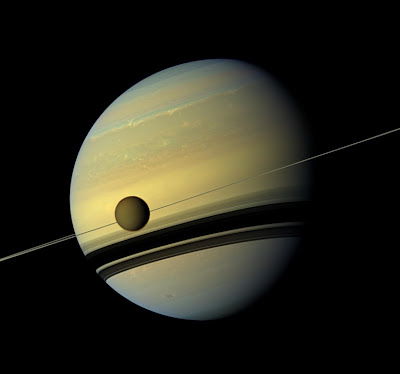Titan and Ad Hoc Explanations
Evolutionary cosmologists get more things wrong than they get right. Using their presuppositions, they make predictions. (Don't we all?) The problem is, whenever the space probes get close enough to celestial objects that are the subjects of scientists' predictions, the preductions are incorrect.
These scientists do great calculations and can describe the present, but when it comes to explaining planetary origins, they do poorly. In fact, they make up some nice stories that have no substantive basis. But they must have an ancient universe, because evolutionists must have huge amounts of time to plug into their conjectures. Creationists do not have these problems.
 |
| NASA/JPL-Caltech/Space Science Institute |
Like Enceladus, Saturn’s moon Titan shows multiple signs of being far less than 4.5 billion years old – yet the press releases are strangely silent about the implications.
As we showed recently with Enceladus (8/7/13), planetary scientists become oddly silent about evidences that conflict with their old-age assumptions. Another case is Titan, Saturn’s largest moon.
Case of the disappearing methane: Titan’s methane may dry up, a surprise announcement said on Space.com, where Megan Gannon wrote, “the compound doesn’t seem to be getting replenished fast enough on Titan’s surface to keep the methane cycle sustainable, scientists say.” She was referring to a JPL press release (echoed on NASA Astrobiology Magazine) that asked if the methane is “going, going, soon to be gone” (cf. 4/16/13). The articles acknowledged the ongoing photodissociation of methane by the solar wind, hinting that ethane should accumulate on the surface – but the observed lakes present far less than previously calculated (scientists had expected to find a global ocean of methane and ethane about half a kilometer deep). Icarus said that over half the surface liquid should be ethane, presumably from the solar wind breakdown. Christophe Sotin thinks the methane disappearance may be tens of millions of years in the future, but readers should ponder that ten million years is 1/450th the assumed age of Titan. To rescue the assumption that Titan is billions of years old, the press release posited an unobservable, ad hoc event: “The team suggests that the current load of methane at Titan may have come from some kind of gigantic outburst from the interior eons ago possibly after a huge impact.” It’s not known, though, whether a reservoir of methane exists under Titan’s surface that could be excavated by an impact.You can read about the other problems and evolutionary guesswork by following this link to "Scientists Dodge Youthfulness of Saturn Moon Titan".